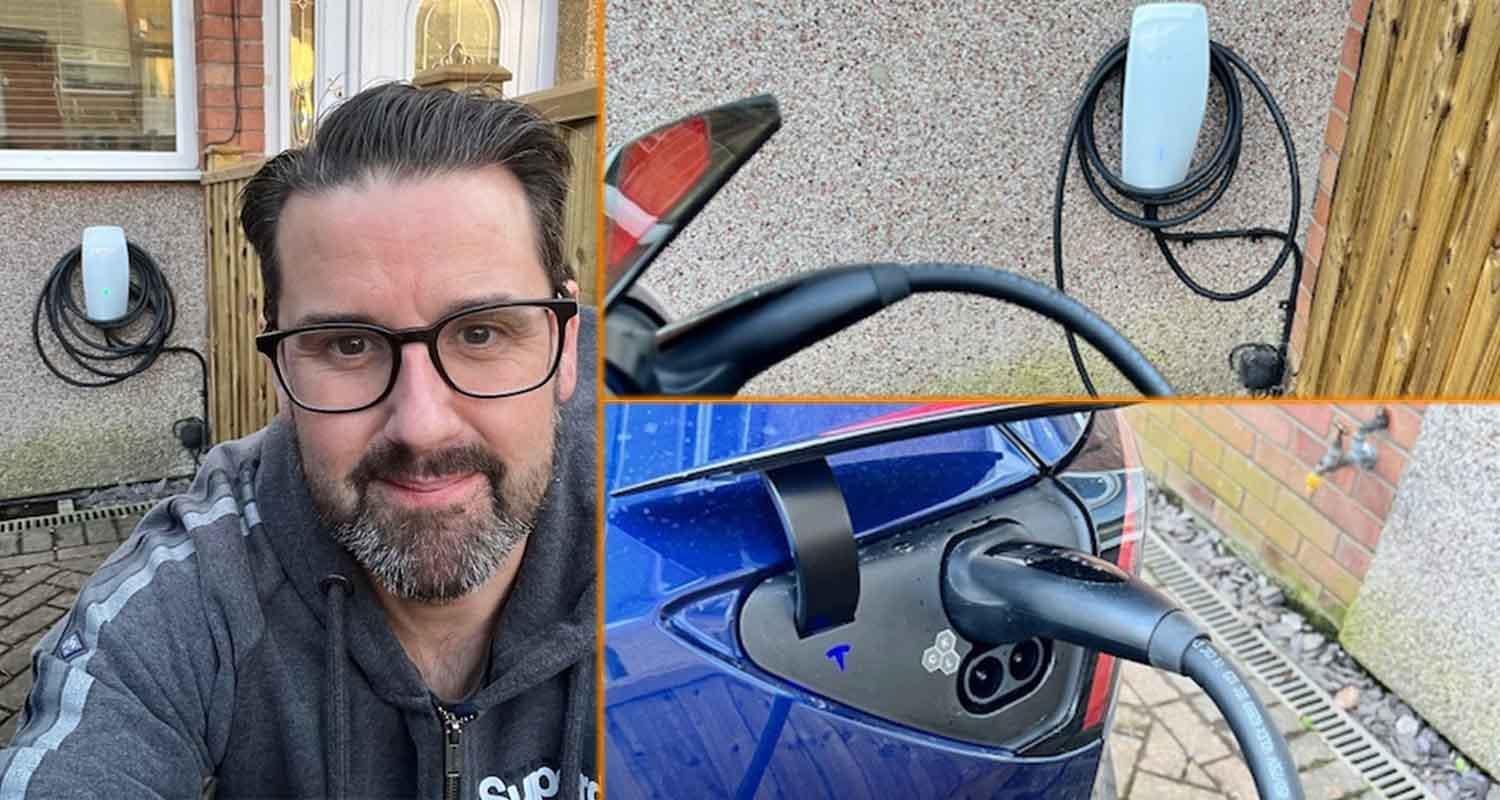Plugged-in Michael Goulden - Kerbo Charge co-founder and chief executive

Here at Smart Home Charge, we’re obviously serious advocates for the convenience and cost savings that can be unlocked when charging at home.
However, it’s not always possible without off-street parking. It’s why there needs to be a mix of solutions for those living in terraced houses, flats and for anyone without access to off-street parking to make sure they can easily and affordably charge their electric car.
Kerbo Charge was founded by Michael Goulden and Ben Whitaker in 2021 to help solve this problem so any EV driver that has parking outside their house, but doesn’t have off-street parking, can have a smart home charger installed and a safe route across the pavement to plug it into their vehicle.
The company works with local authorities (LA) to channel a gully from the house, across the pavement to the on-street parking. The latest Government statistics predict there are around 6.9 million terraced houses across the UK where this cross pavement solution could be used to help get more drivers into EVs.
EV drivers can insert their cables securely into the gully within 30 seconds. That channel through the pavement ensures there is a secure place to trail the cable with minimum impact to the pathway and pedestrians.
Kerbo Charge said the lid to the gully closes itself and is able to withstand 15kN of pressure, which is equivalent to an articulated lorry driving over the top.
The cross pavement solution was born out of Goulden’s own frustration with using public charging infrastructure for his first EV in 2021.
He said: “I made the jump to get an EV because my local council in London had put a charger in on the next street along.
“But we immediately became frustrated with the inconvenience and cost of public charging.
“It was 30p/kWh to charge back then at a 7kw destination charge and the price has just gone up and up to the point where it’s similar to filling up with petrol.”
This frustration with public charging reached a tipping point one rainy evening when Goulden needed to charge and ended up at a charger that just wasn’t working.
He said: “I just knew there had to be a better way.”
Get £5 free charging
If you don't have a driveway or use public charging a lot then you need Electroverse, the charging service that allows you to charge at 100s of networks with one single account. Sign-up and get £5 free.
Partnering with Local Authorities

Kerbo Charge works directly with LAs to gain the permission to channel out the gullies across pavements for customers.
The business often even works directly with LAs’ own highways contractors to carry out the work.
Milton Keynes was the first to work with Kerbo Charge to offer the solution to residents. The business is now working on trials with five LAs in total, including Durham, Reading, West Berkshire and East Lothian. Many more are due to come on board.
Goulden said partnering with LAs and knowing their exact requirements has been an essential part of building out the Kerbo Charge offering.
It means that Kerbo Charge can only operate in those areas where it is collaborating directly with LAs. But this also means that the company takes care of all the LA approvals that are needed on behalf of the customer.
Goulden said: “We’re definitely at a stage where LAs are reaching out to us to start new trials.
“Where we want to get to with this is to show the evidence that trials have been done in multiple locations successfully.
“We can then get to a point where we’re rolling this out at a wider scale across towns and cities in the UK.”
Some of the sticking points for cross-pavement solutions

On the face of it, the Kerbo Charge solution seems like it’s a pretty simple concept for LAs to understand and introduce.
However, there are still some considerations that can slow down whether it can be introduced.
Some LAs already have a public charging strategy in place for off-street parking, which includes the provision of 7kW destination chargers.
Changing that policy to now include an approved cross pavement solution can take a bit of time, or sometimes be trickier than including cross pavement solutions from the start.
Goulden said some urban locations are also concerned about disruption to high traffic pedestrian footfall areas. Although the easy counter to this is that installing the gully in the first place is helping to solve the problem caused by trailing cable tripping hazards.
Goulden said: “There has to be a mosaic approach to this problem of on-street charging.
“I completely understand that LAs can’t just automatically adopt every solution, but if residents are asking for it, they need to have a look at their policy.”
Another question LAs can sometimes have is around liability and maintenance. Goulden said there are two options. Either the resident accepts liability and maintenance, or the LA can.
What happens if a resident moves house and the new resident doesn’t take on liability for the gully? What happens if a communications company needs to come and dig up the road?
Goulden said: “We now have really clear positions on each of these common queries. We completely understand them, but we can help provide peace of mind to LAs and customers on those topics.”
The public liability insurance may sound slightly scary, but all it requires is to make sure that residents have pushed the cable into the channel correctly. If that’s been done, which is the whole point of the solution being installed in the first place, there’s no way someone can trip over the gully.
Goulden said: “There really should be no issue. The licence is really to make sure residents understand their responsibilities.”
What happens during a Kerbo Charge install?

The process will generally take between 1 hour to an hour and a half. A Kerbo Charge engineer or highways contractor will come and visit the house, chat through the location for the gully and then get on with the installation. After that, it’s ready to be used to start charging.
Kerbo Charge recommends customers to have at least 10 metres of cable to make sure there is enough length to reach from the home charge point and through the gully, across the pavement and to the car.
Goulden said: “Having that longer cable will also give you a bit more flexibility if you’re parking one space up or down from just outside your house too.
“In an ideal world, you can charge right outside your house. Sometimes the cable will need to run a short length down the gutter where it can pop up to plug into your car.”
Musical chairs

One of the biggest questions that usually comes up from customers thinking about Kerbo Charge is what happens if you can’t park directly outside your house?
Goulden said that he has to be honest and say that if residents find it difficult to regularly get a spot either directly outside or close by to their house, the Kerbo Charge solution might not be for them.
However, he said it’s likely that most people will be able to get a spot outside their house for the one or two times a week that most people with an EV will need to charge.
Goulden said: “Some neighbours can also be understanding and in my own experience I can just WhatsApp my nextdoor neighbour and ask them nicely to move up a space so I can charge that particular day.
“You have to be honest with yourself about your circumstances.”
Funding available for cross-pavement solutions

Goulden’s perfect future for EV charging infrastructure is that as many people as possible have the ability to charge at home. This would then be combined with a high-speed network of chargers on A roads and motorways.
He said: “I think we’re going in the right direction with rapid chargers and hubs. The other end of the spectrum is the slower neighbourhood chargers.
“As you would expect, I’m more sceptical as to whether the investment is going into the right place when it comes to neighbourhood destination chargers.
“If we spend too much money on putting in 7kW chargers, there’s a real risk we create assets that people don’t really want to use. If they’re costing residents 55p/kWh, will people actually use them?
“These neighbourhood chargers also need to be available to the point where they’re close to everyone’s home. If you’re charging overnight, you need the car close by and people don’t want to walk too far from where they’re charging.”
Goulden’s view, as you might expect, is that a share of the funding should be shifted to approved cross-pavement products.
The Office for Zero Emission Vehicles (OZEV) has already confirmed that the budget will be available to help with cross-pavement products. This should mean a £350 discount to help towards the cost of installation.
Goulden said: “I had a meeting with OZEV in November and they’re working through the details on making that funding available.
“It’s likely there will be a subsidy of £350 available for anyone that’s putting in a council-approved cross pavement solution if they’re also putting in a home charger at the same time.”
While it’s a helpful contribution, it’s still a relatively small percentage of the total cost of a Kerbo Charge installation, which is around £1,000.
Goulden said: “What we’d like to see more is for LAs to use their Local EV Infrastructure (LEVI) fund to help pay for cross pavement solutions like ours, particularly for anyone on low incomes.”
The £20 million LEVI fund supports LAs in England to plan and deliver charging infrastructure for residents without off-street parking.
Those LEVI funds would help take care of the cost of the Kerbo Charge installation and the home charger too.
Goulden has said there is some positive news in that some LAs are already engaging and using LEVI funds to help pay for cross-pavement solutions, so it is already happening.
His final sign off for the interview was to let residents know that if Kerbo Charge isn’t yet operating in your area, the company is working hard to expand trials to more LAs.
He added: “If you’re a resident and you’re looking for a cross-pavement solution like ours, I would really encourage you to reach out to your council and speak with them about what you would like and what you would use.
“The more residents get in touch and ask them, the more likely they are to look at what is available and think about approving cross pavement solutions.”











